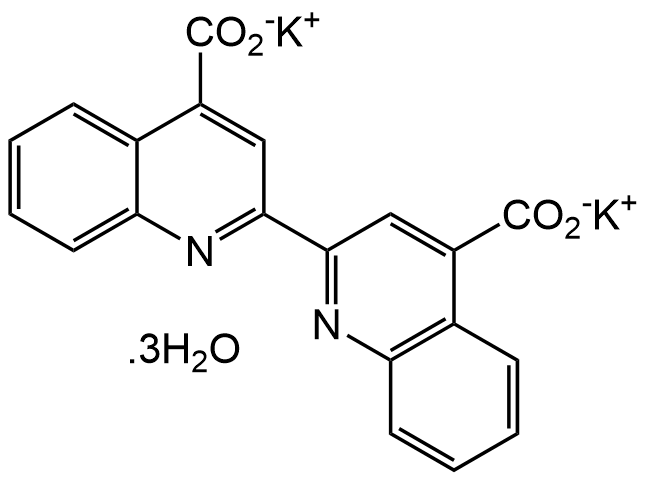2,2'-Bicinchoninic acid dipotassium salt trihydrate
| Code | Size | Price |
|---|
| CDX-B0719-G005 | 5 g | £92.00 |
Quantity:
| CDX-B0719-G025 | 25 g | £335.00 |
Quantity:
Prices exclude any Taxes / VAT
Overview
Regulatory Status: RUO
Shipping:
Ambient
Storage:
Short term: +20°C. Long term: +20°C
Images
Documents
Further Information
Alternate Names/Synonyms:
BQC; Potassium [2,2'-biquinoline]-4,4'-dicarboxylate
Appearance:
Off white to light red solid.
CAS:
207124-63-8
EClass:
32160000
Form (Short):
solid
GHS Symbol:
GHS07
Handling Advice:
Protect from light and moisture.
Hazards:
H315-H319-H335
InChi:
InChi=1S/C20H12N2O4.2K.3H2O/c23-19(24)13-9-17(21-15-7-3-1-5-11(13)15)18-10-14(20(25)26)12-6-2-4-8-16(12)22-18;;;;;/h1-10H,(H,23,24)(H,25,26);;;3*1H2/q;2*+1;;;/p-2
InChiKey:
MUCQANVZZZELIW-UHFFFAOYSA-L
Long Description:
Chemical. CAS: 207124-63-8. Formula: C20H10K2N2O4 . 3H2O. MW: 474.55. 2,2'-Biquinoline-4,4'-dicarboxylic acid dipotassium salt (BQC) is a water soluble biquinoline-based ligand. The oxidation of alcohols to the corresponding aldehydes and ketones, which can be performed by a variety of methods, remains one of the most important reactions in organic synthesis. BOC is used in the aerobic oxidation of alcohols (primary, secondary and benzylic) in the presence of palladium catalysts. The catalytic system composed of CuCl2 and BQC was found to be highly efficient for the selective oxidation of secondary benzylic, allylic and propargylic alcohols to the corresponding ketones, with aqueous t-butyl hydroperoxide under phase-transfer catalysis conditions. The catalytic system is stable and can be recycled and reused several times without loss of activity. Since the reaction solvent is only water and the oxidant is air, it may be used as a solvnt-free green alternative to the traditional methods of oxidation. BOC has also been used as an aqueous-phase catalyst for the hydrogenation of nitriles. As a complexing agent, BOC assists in the identification, extraction, and quantification of metal residues. BOC has been used for the determination of copper in wine. It binds to Cu(I) and forms a water-soluble complex that absorbs strongly at 562 nm.
MDL:
MFCD00191791
Molecular Formula:
C20H10K2N2O4 . 3H2O
Molecular Weight:
474.55
Package Type:
Vial
Precautions:
P264-P280-P302+P352+P332+P313+P362+P364-P305+P351+P338+P337+P313
Product Description:
2,2'-Biquinoline-4,4'-dicarboxylic acid dipotassium salt (BQC) is a water soluble biquinoline-based ligand. The oxidation of alcohols to the corresponding aldehydes and ketones, which can be performed by a variety of methods, remains one of the most important reactions in organic synthesis. BOC is used in the aerobic oxidation of alcohols (primary, secondary and benzylic) in the presence of palladium catalysts. The catalytic system composed of CuCl2 and BQC was found to be highly efficient for the selective oxidation of secondary benzylic, allylic and propargylic alcohols to the corresponding ketones, with aqueous t-butyl hydroperoxide under phase-transfer catalysis conditions. The catalytic system is stable and can be recycled and reused several times without loss of activity. Since the reaction solvent is only water and the oxidant is air, it may be used as a solvnt-free green alternative to the traditional methods of oxidation. BOC has also been used as an aqueous-phase catalyst for the hydrogenation of nitriles. As a complexing agent, BOC assists in the identification, extraction, and quantification of metal residues. BOC has been used for the determination of copper in wine. It binds to Cu(I) and forms a water-soluble complex that absorbs strongly at 562 nm.
Purity:
>98%
Signal Word:
Warning
SMILES:
[K+].[K+].[H]O[H].[H]O[H].[H]O[H].[O-]C(=O)c1cc(nc2ccccc12)-c3cc(C([O-])=O)c4ccccc4n3
Solubility Chemicals:
Soluble in water.
Source / Host:
Synthetic
Transportation:
Non-hazardous
UNSPSC Number:
12352200
Use & Stability:
Stable for at least 2 years after receipt when stored at RT.
References
(1) G. Ferguson & A.N. Ajjou; Tetrahed. Lett. 44, 9139 (2003) | (2) A.N. Ajjou & J.-L. Pinet; J. Mol. Catal. A: Chem. 214, 203 (2004) | (3) B.P. Buffin, et al.; J. Mol. Catal. A: Chem. 225, 111 (2005) | (4) J. Boudreaz, et al.; Tetrahed. Lett. 47, 1695 (2006) | (5) A.N. Ajjou & G. Ferguson; Tetrahed. Lett. 47, 3719 (2006) | (6) D.M. Chisholm & J.S. McIndoe; Dalton Trans. 30, 3933 (2008) | (7) A. Rahman, et al.; Chin. Chem. Lett. 22, 691 (2011) | (8) A.N. Ajjou & A. Robichaud; Appl. Organometall. Chem. 32, e4547 (2018) | (9) K. Krommyda, et al.; Catal. Lett. 149, 1250 (2019) | (10) N. Kontoudakis, et al.; Austr. J. Grape Wine Res. 26, 121 (2020)



